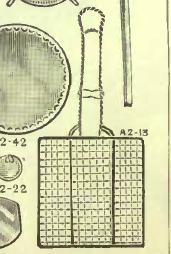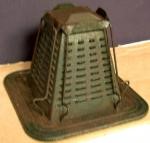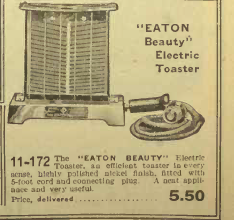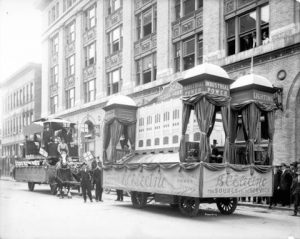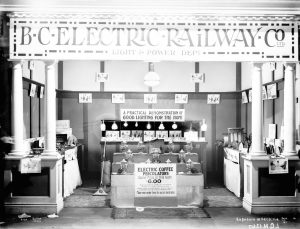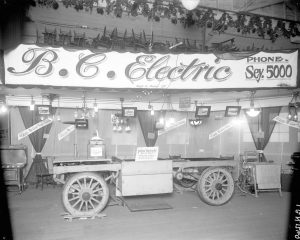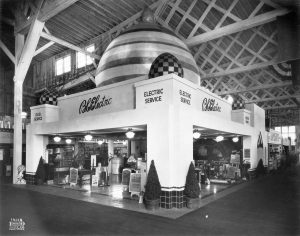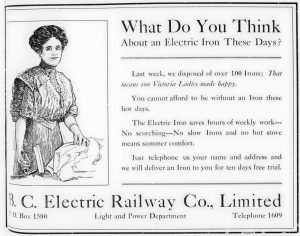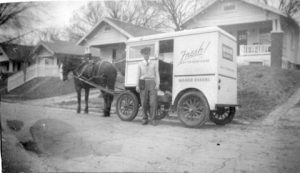Automatic Toasters
Automatic toasters ensured more people ate toast for breakfast. A recent survey found that one out of four Canadians currently make toast their breakfast food[i]. In British Columbia this practice may be partly attributed to marketing campaigns by BC Electric Railway (later BC Electric, now BC Hydro).
“ In June 1923 B.C. Electric organized an electric toaster campaign similar to its earlier electric iron campaign. Calculating that each newly installed electric toaster represented an additional three dollars per year in added revenue, B.C. Electric joined forces with a Vancouver bakery to distribute toasters throughout its local market. B.C. Electric placed billboards on the sides of its streetcars and the bakery’s delivery-wagon drivers were armed with toasters and instructed to offer them for sale to every household on their route. The slogan for the campaign was simple: “Make Toast Your Breakfast Food.” (Stadfeld, 2002, p. 191)
Toasting bread is an ancient practice. Early civilizations placed bread over an open fire in order to preserve it, to keep it from growing mold. The bread was toasted on a hot stone in front of the fire.
Later on, simple toasting devices were created to cook the toast more evenly such as wire frames or racks (like the images from 1909 and 1920 editions of Eaton’s Catalogue) and toasting forks for use over an open fire or gas flame.
With the arrival of wood and coal stoves in the 1880s, a new toasting method was needed. This led to a tin and wire pyramid-shaped device. Bread slices were placed on the outside of the toaster and the device was heated on the stove, similar to camping toasters still used today.
Electrical Challenges
The technical challenge for the early electric toasters was to develop a heating element able to sustain repeated high temperatures. In 1905 Albert Marsh created Nichrome, a filament wire with an alloy of nickel and chromium that was safe and durable when heated. This electric resistance coil which allowed the application of electricity to heat-generating appliances and led to the development of electric appliances such as irons, percolators and toasters. Within months of Marsh’s invention, other inventors were using Nichrome to produce electric toasters.
The first versions of an electric toaster consisted of a cage-like device with a single heating element. It toasted one side of a slice of bread at a time; the bread had to be flipped by hand to toast the other side. Toasters also had to be plugged into the light bulb socket.
In the early 1900s, most North American homes had limited access to electrical power, and the electric toaster was mostly used in restaurants until the standard electrical outlet was agreed upon by electrical manufactures in North America in 1917, and the popup toaster was invented in 1919.
An English company, BC Electric Railway (BCER) was formed in 1897 to buy existing street railways and electric utilities in Vancouver, Victoria and New Westminster. It bought out several smaller utility companies that had been generating power in various locations. Initially steam and coal were used to generate electricity but as street car traffic and the number of electric lights doubled between 1898 and 1900, BCER turned to hydro power. Hydro electric generating plants were expanded to various places: Buntzen-Lake Coquitlam; Stave Lake; Goldstream and Jordan River on Vancouver Island. BCER also purchased Burrard Power which had control of the Lillooet River.
BCER publicized the electrical advances in public events such as parades. A photo from the Vancouver Archives portrays a BCER float that included the first BC Street Car and a small model of the Buntzen Lake Power House, c. 1914.
When BCER had surplus power, particularly in the non-peak hours, it became necessary to convince people to abandon long established methods of cooking, cleaning and lighting their homes. The marketing manager of BC Electric promoted small appliances such as toasters, percolators and irons as being more effective in increasing off peak power use than electric stoves because extra wiring was not required.
Various strategies were used to introduce and spread the use of electrical appliances.
Local trade shows were important venues for the development of the electric industry. In 1919, Vancouver hosted its first annual Electric Convention with representatives from General Electric and Westinghouse in attendance. The theme of the convention was cooperation. W.G. Murrin of B.C. Electric gave a talk entitled “Merchandising from a Central Station’s Point of View.” He emphasized selling electricity and promoting the sale and use of electric appliances.
Exhibitions and fairs also provided opportunities to advertise. BC Electric frequently supplied free lighting for exhibitions such as the first Vancouver Industrial Exhibition that was held in 1910 and at some early agricultural exhibitions. Displays were prepared to exhibit and promote electrical products. Here are two early examples from Vancouver Archive (circa 1913, 1914).
The displays got more sophisticated at the years went on. Here is one, also from Vancouver Archive from the 1928 Pacific National Exhibition.
Promotional Offers, Time Payment Plans and Cheap Loans
In 1916 a BC Electric campaign successfully flooded Vancouver with electric irons. B.C. Electric’s technique was to divide the city into sections and dispatch salesmen with horses and buggies to leave a new electric iron at every house on B.C. Electric’s electric system. No initial payment was requested. Housewives were encouraged to use the iron for four days. If they decided to keep it they were charged $1 cash and a further $4 at one dollar a month on their electricity bill. Apparently, less then ten percent were returned.
The Great War had been tough and the federal government brought in a luxury tax on many consumer goods. The world had started to come back to normal by Christmas 1920, so the tax was lifted. Retailers were ecstatic. Toasters were advertised along with other electrical gifts for Christmas presents[iii].
The very successful promotion of electric irons[ii] in 1916, led to a similar campaign for toasters in 1923, as indicated in the introduction to this blog.
Door to Door Bakery delivery in Vancouver (circa 1920). Source Vancouver Archives.
The automatic toaster debuted in 1926. It toasted both sides and popped up the finished slice which boosted toaster sales. Sales also got a boost with the invention of sliced bread. According to Vancouver History that invention didn’t reach Vancouver until 1937.
Canadians tend to take longer to warm to new-fangled stuff, so it’s no surprise that sliced bread, which had been available in some US cities for a few years, didn’t get to Vancouver and the rest of BC until July 19, 1937. We know who developed it: he was an Ohio jeweler named Otto Rohwedder, and he worked for 13 years on perfecting his machine. Bakers told him to forget it, because sliced bread would get stale faster. So Rohwedder went back to his drawing board and developed a machine that first sliced bread, then wrapped it.
Who knows why we eat toast for breakfast? It may simply be free choice, but we can never underestimate the power of advertising and marketing.
Old toasters are collectibles. If you ever travel the Stewart-Cassiar highway consider stopping in at the Toastworks Museum in Stewart, where Frank Kamermans, has over 1500 vintage toasters on display.[iv]
References:
These five theses and dissertations are excellent sources of more detailed information.
Gucciardo, D. (2011). The Powered Generation: Canadians, Electricity, and Everyday Life [PhD dissertation] Western University, London, Ontario. Electronic Thesis and Dissertation Repository. 258. https://ir.lib.uwo.ca/etd/258
Roy, P. (1979). The British Columbia Electric Railway Company, 1897-1928. [Masters Thesis]. University of British Columbia, Vancouver, BC.
Stadfeld, B. (2002). Electric Space: Social And Natural Transformations In British Columbia’s Hydroelectric Industry To World War Ii [PhD. Dissertation]. Winnipeg, MA: University of Manitoba
Taylor M. D. (1965). The development of the electricity industry in British Columbia. {Master Thesis] Vancouver, BC: University of British Columbia
Tothill, B. (1997). Living Electrically: The British Columbia Electric Railway Company and the Development of the Domestic Electric Appliance Market in Victoria, 1919-1939. [Masters Thesis] University of Ottawa, Ottawa, Ontario.
Footnotes:
[i] https://www.statista.com/statistics/441688/frequency-of-eating-toast-for-breakfast-canada/
[ii] https://search-bcarchives.royalbcmuseum.bc.ca/what-do-you-think-about-electric-iron-these-days-bc-electric-victoria-advertisement
[iii] https://vancouversun.com/news/local-news/this-week-in-history-1920-retailers-bounce-back-at-christmas
[iv] http://www.vancouversun.com/entertainment/movie-guide/pete+mcmartin+here+toast+stewart+with+video/10015593/story.html;
http://northword.ca/june-2007/a-frank-take-on-toasters



